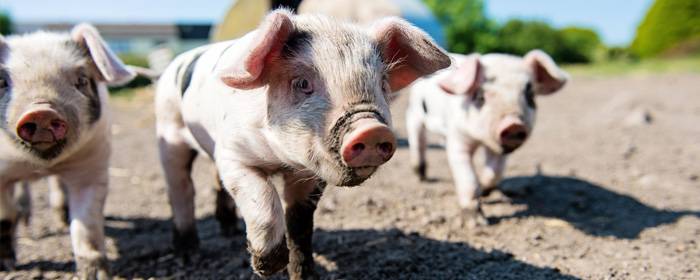Our Pigs

Primrose Herd itself is a mixture of traditional breeds, all of which have special qualities.
Gloucester Old Spots and Large Blacks are reared on the family farm. Tamworths, Welsh, and British Lops are sourced from neighbouring farms in West Cornwall, all of which share our ethos and standards.
The pigs are reared outdoors, and enjoy a better diet and slower growth than commercial production methods allow. Rare breed or traditional breed pigs are the ancestors of today’s modern commercial pigs. They mature slowly and because many live outdoors they develop muscles and fat needed to survive outside. This gives them a higher fat content and a special taste and texture, whilst the meat remains moist and succulent. Modern pigs have hardly any fat whether as visible back fat or marbling within the muscle. That layer of back fat means that when the meat is cooking it is being basted in its own fat, making the meat succulent and full of flavour.
Large Black
With its lop ears and long deep body, the Large Black is Britain’s only all black pig. Extremely docile and very hardy, it is ideally suited to outdoor systems. The breed originates from the Old English Hog established in the 16th and 17th centuries. By the late 1880’s there were two distinct types of Large Blacks. One found in East Anglia and the other in Devon and Cornwall. The founding of the Large Black pedigree Society in 1889 led to an increase in the exchange of stock between breeders in the two regions. In the early part of the 20th Century Large Blacks were widely distributed throughout the country and were frequently crossed with Large Whites and Middle Whites to produce bacon and pork pigs. A change in demand within the meat trade and a developing prejudice against coloured pigs led to a severe decline in numbers during the 1960’s. Today Large Blacks can be found throughout the country mainly in small herds, some of which were established well before World War 2. Large Black sows are renowned as excellent mothers with exceptional milking ability. They are able to raise good sized litters without a huge input of food. The Rare Breeds Survival Trust list the Large Black as vulnerable, with just 326 registered sows and 74 breeding boars in 2013.
Gloucestershire Old Spot
The Gloucestershire Old Spot breed is probably the best known pig breed in Britain today. Established with a breed society in 1913, it is the oldest spotted pig breed in the world. Originally popular in the Berkeley Vale of Gloucestershire, they were known as the Orchard Pig. They grazed in the apple orchards clearing up the windfalls as they went. The Gloucestershire Old Spot is a large, meaty animal with a broad and deep body and large hams. Its white coat has large clearly defined spots. Their legs and feet should be strong and straight and their ears should cover their faces coming down to their noses. The Gloucester Old Spot has many advantages – it is an ideal breed for small scale production and is specifically suited to an outdoor rearing system. The sows are docile and hardy and make excellent mothers. The Dams are extremely milky and in many cases will continue breeding at a greater age than many other breeds. There is a huge demand for the high quality meat produced from Gloucester Old Spot pigs. Experience shows that good management can produce excellent meat without excessive fat coverage. Meat of such quality is in demand and many butchers are now specialising in it. The breed is the largest numerically of the pig breeds listed by The Rare Breeds Survival Trust with a total of 1524 sows and 204 boars registered with The British Pig Association.
British Saddleback
The British Saddleback is the result of the amalgamation of two similar breeds, The Essex and Wessex Saddlebacks.
The Essex pig was found mainly in East Anglia. These pigs had black heads and neck as well as a clearly defined belt of white extending over the shoulders and continuing over the forelegs. The rest of the body was black with the exception of white feet and the tip of the tail.
The Wessex originated in the New Forest as a cross between two indigenous old English bacon pigs. By 1914 the breed was also found in the South and South West. It was black all over apart from a continuous band of white hair over the forelegs and shoulder.
The respective breed societies amalgamated in 1918 and the herd books followed suit in 1967 when the British Saddleback breed was established.
Both breeds enjoyed great popularity during the Second World war when 47% of the total pedigree sow registrations were from the Essex and Wessex Breeds. Although the sows retained their popularity during the post war years, the boars lost out to white breeds. The recommendations of the time were to cross sows of either breed with a white boar to produce a dual-purpose pig for combined bacon and pork production.
British Saddlebacks are hardy and noted for their mothering ability. The breed continues to be used mainly to provide coloured dams for the production of first-cross porkers, baconers and heavy pigs. The breed is known for its grazing ability and is very hardy. It has secured a niche in outdoor and organic production.
The British Pig Association’s annual breed survey for 2013 shows there are 621 breeding sows and 139 breeding boars.
